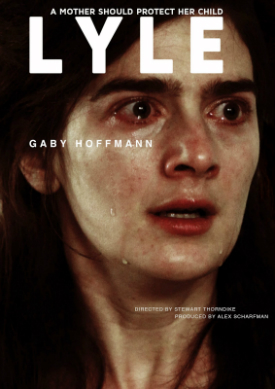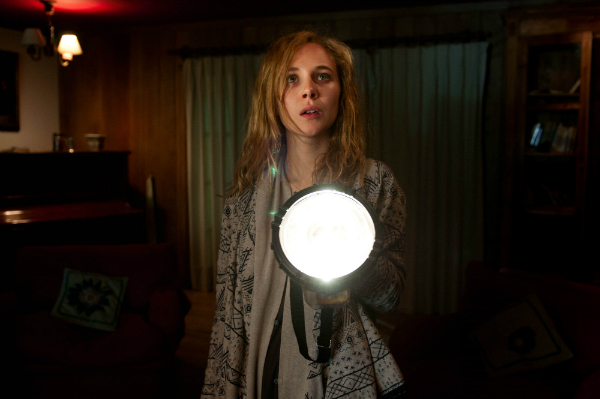
Written by Amanda Rodriguez.
I was excited to review female-directed (Stewart Thorndike‘s) Lyle, a FREE streaming independent film and a reboot of (pedophile) Roman Polanski’s classic film Rosemary’s Baby. Like Rosemary’s Baby, Lyle stars a pregnant woman who becomes more suspicious and more isolated every day, fearing a conspiracy to harm her unborn child. Unlike Rosemary’s Baby, Lyle‘s lead character Leah (Gaby Hoffman) is a lesbian, and her first-born daughter, Lyle, dies under mysterious circumstances. Though billed as a horror movie (and, in some inexplicable cases, a horror comedy), Lyle is more of a psychological thriller than anything, dissecting the ways in which Leah deals with grief, loss, pregnancy, and motherhood as well as paranoia, aggression, fear, and alienation.
My sister and fellow Bitch Flicks contributor, Angelina Rodriguez, and I live tweeted our viewing of Lyle, using the hashtag #LyleMovie. Aside from being really fun, it also helped us home in on the successes and shortcomings of the film. First of all, we loved actress Gaby Hoffman’s big, beautiful brows and the gap between her two front teeth (these two traits are strong in our own family). Leah often wears ratty, mismatched pajamas, and very few of the characters have styled hair. Overall, we appreciated how real and unmade-up the film’s stars were.

The cast of the film is almost entirely made-up of women. Only one primary character is male, and he’s a Black man. I can’t tell you how refreshing it is for this jaded feminist reviewer to see a cast comprised of groups that media traditionally under-represents!
The downside of a ratio like this, though, is that all Leah’s persecutors (real and imagined) are other women. Most notably, her partner, June, played by Ingrid Jungermann (the creator and star of the lesbian web series F to 7th). Leah and June mostly have a non-affection relationship with little to no physical contact. June is portrayed as an inconsiderate, perhaps murderous partner who may or may not be using Leah. If June is, in fact, using Leah and her baby-making abilities, is June even actually gay, or is that part of the ruse? I don’t like that I found myself questioning the veracity of a character’s sexuality, and it seemed that Lyle encouraged this suspicion.

The film also may have been advancing a weird, regressive perspective on motherhood, as even the poster declares, “A mother should protect her child.” Leah does little other than exist as a pregnant woman. Her identity outside of her status as “mother” is largely unknown to us. Lyle seemed to be seeking to normalize lesbianism through the notion of the nuclear family. For instance, the couple moves into a fancy apartment to accommodate their expanding family. Leah stays at home while June works late hours, and June is constantly gaslighting her pregnant partner. It’s all very traditional and falls within the existing heteronormative paradigm.

On the positive side, we have a self-advocating heroine who is intelligent, clever, and stands up for herself. She never gives into those who seek to erase her fears and her accusations of foul play. Leah is strong and self-preserving (while protecting her unborn child) until the end. Having a hugely pregnant heroine with bushy hair and eyebrows is a beautiful thing. Having the climactic final showdown take place in the birthing room is also seriously badass. Though I didn’t love the implications that could be read into some of the themes in Lyle, it’s moving in the right direction. This is a free, independent horror film starring lesbians that doesn’t seek to exploit their sexuality for the male gaze. It’s very existence is a triumph. Plus, it’s fun to watch.
Bitch Flicks writer and editor Amanda Rodriguez is an environmental activist living in Asheville, North Carolina. She holds a BA from Antioch College in Yellow Springs, Ohio and an MFA in fiction writing from Queens University in Charlotte, NC. Her short story “The Woman Who Fell in Love with a Mermaid” was published in Germ Magazine. She writes all about food and drinking games on her blog Booze and Baking. Fun fact: while living in Kyoto, Japan, her house was attacked by monkeys.







